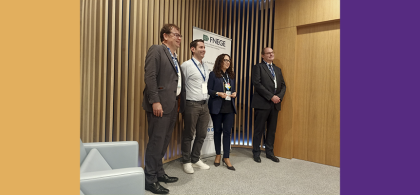
Digital or ecological: do you have to choose?
On the one hand, new digital technology strengthens industrial performance; on the other, the circular economy helps create green jobs and enhance firms’ green performance. An experimental study by a team of researchers – including NEOMA’s Charbel Jose Chiappetta Jabbour – has shown how adopting these two transformations in tandem benefits a company’s long-term economic, environmental and social performance.
The sixth assessment report published by the United Nations Intergovernmental Panel on Climate Change (IPCC) states that global industry is responsible for 24% of greenhouse gas emissions. According to expert opinion, this impact can be cut by embracing all possible mitigation measures throughout the value chains of the manufacturing sector, including improving the energy efficiency of processes; introducing circular strategies for resources; and adopting transformative changes in production processes.
These issues lie at the heart of two major transitions: digitisation and the decarbonisation of industry. Given the size of these transformative changes, the key stakeholders are puzzling over the best strategies for the future of their business activities. What measures should they prioritise to make their companies more competitive? Should one transition be preferred over the other? In an attempt to answer these questions, the researchers surveyed supply chain managers working for companies in Brazil. Their aim was to assess how the isolated or joint adoption of future industrial technologies and a circular economy model might affect the sustainable performance of manufacturers.
Two transitions for boosting corporate sustainability
Digitisation is based on the notion of the industry of the future or Industry 4.0, which is built on the Internet of Things, cloud computing, 3D printing and the development of smart sensors. Adopting these technologies makes industry more flexible; processes can be planned and tracked in real time; and companies can react with agility if there are any glitches. For all of the above reasons, the researchers demonstrated that integrating digital technology enhances the long-term economic, environmental and operational performance of companies operating in Brazil.
The growing pace of the energy and ecological transition is obliging companies to step up their efforts to cut greenhouse gas emissions. Against this background, the circular economy – which accounts for only 9% of the world economy – has been identified as an attractive alternative to today’s linear production systems. With its closed-loop system, the waste generated by some companies becomes a resource for others. This economy also supports new production and service models based on extending the lifespan of products, devising maintenance and repair services, and refining the use of resources. This includes, for example, renting out batteries for electric vehicles or production machines. The study once again shows that this type of business model has a positive effect not just on the economic, environmental and operational performance of Brazilian manufacturers but also on their social performance. Why? Because the circular economy generates new jobs and entrepreneurial businesses. But what happens when a company adopts both practices?
Industry 4.0 and the circular economy: more complementary than contradictory
When replying to the question: “Which transformation should you prioritise?”, the survey’s answer is simple: “Both”. It proves that adopting Industry 4.0 technologies and a circular economy model together has even more benefits for a company: it builds on the positive commercial and social effects observed in either case. What does this mean in concrete terms?
The researchers explain that modernisation and circularity are two sides of the same coin. In its quest for sustainable performance, it is in a company’s best interests to consider the total value of both sides of the coin… rather than basing their strategy on simply tossing it in the air. Since the performance gains are higher, this global approach could result in a distinctive competitive edge over time: by opening up new areas of competitiveness, for instance, built on circular and digital supply chains.
The researchers also note that the Brazilian context is similar to that found in 60% of the countries assessed by the World Economic Forum, where the digital transformation is just getting started. These results are an incentive for manufacturers to combine the two practices as they develop. On the other hand, the survey suggests that countries where the digital approach is more advanced should supplement their model with a strategy grounded in the circular economy. If they do, their business will increase and will satisfy the growing ecological and energy requirements with the aim of achieving carbon neutrality by 2050.
Find out more
“Better together”: Evidence on the joint adoption of circular economy and Industry 4.0 technologies – Ana Beatriz Lopes de Sousa Jabbour, Charbel Jose Chiappetta Jabbour, Tsan-Ming Choi, Hengky Latan – International Journal of Production Economics, Volume 252, 2022 – https://doi.org/10.1016/j.ijpe.2022.108581



